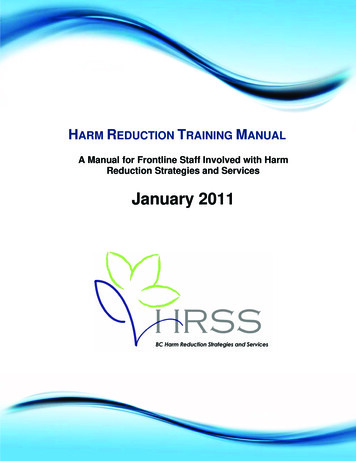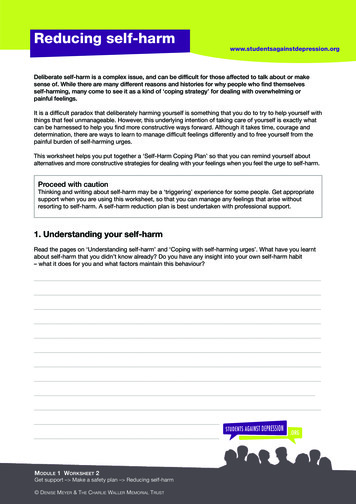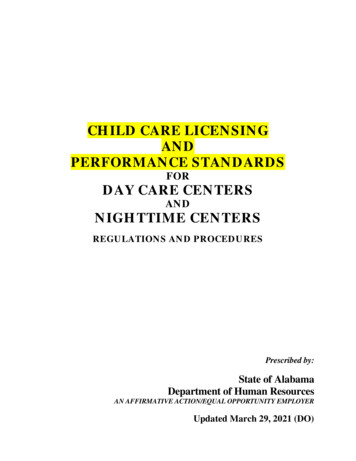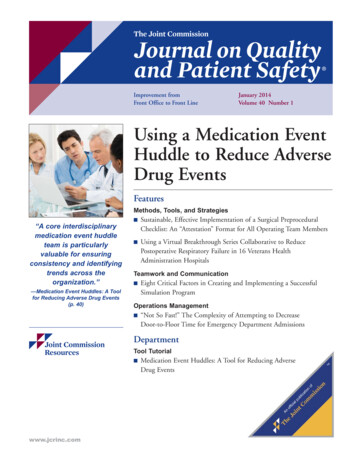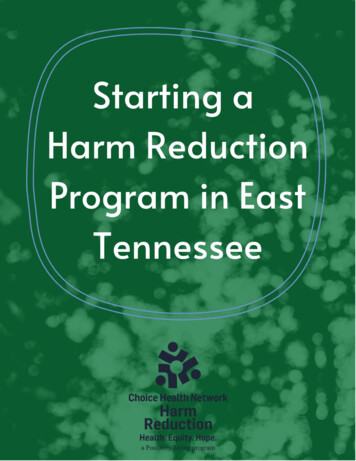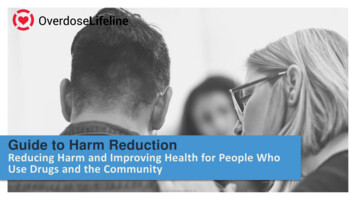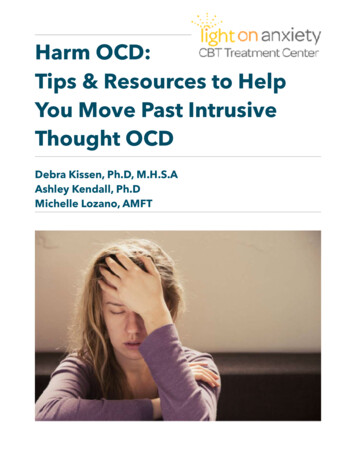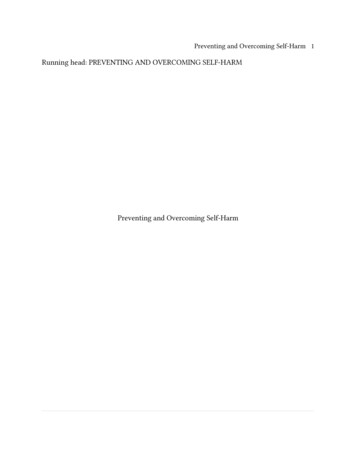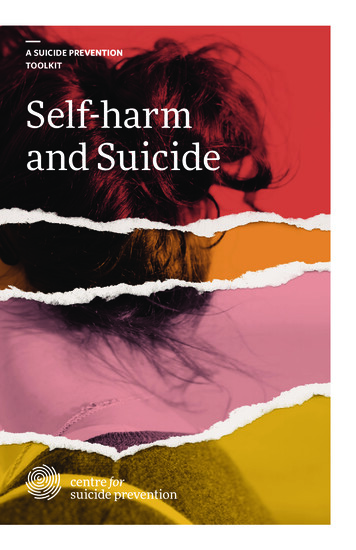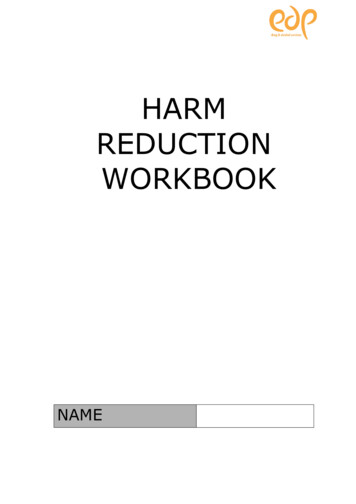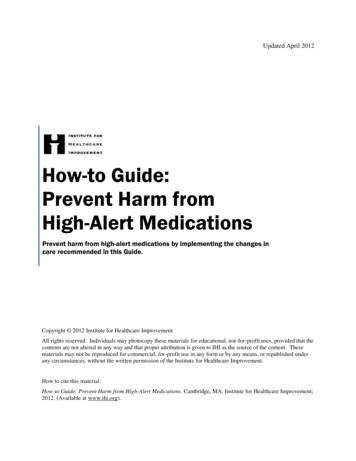
Transcription
Updated April 2012How-to Guide:Prevent Harm fromHigh-Alert MedicationsPrevent harm from high-alert medications by implementing the changes incare recommended in this Guide.Copyright 2012 Institute for Healthcare ImprovementAll rights reserved. Individuals may photocopy these materials for educational, not-for-profit uses, provided that thecontents are not altered in any way and that proper attribution is given to IHI as the source of the content. Thesematerials may not be reproduced for commercial, for-profit use in any form or by any means, or republished underany circumstances, without the written permission of the Institute for Healthcare Improvement.How to cite this material:How-to Guide: Prevent Harm from High-Alert Medications. Cambridge, MA: Institute for Healthcare Improvement;2012. (Available at www.ihi.org).
How-to Guide: Prevent Harm from High-Alert MedicationsInstitute for Healthcare ImprovementContentsIntroduction .3What is the Institute for Healthcare Improvement (IHI)? . 3What is a How-to Guide? . 3Contributors. 3What Are High-Alert Medications? . 4Why Focus on Reducing Harm from High-Alert Medications? .5Anticoagulants: The Evidence .8Narcotics: The Evidence . 10Insulins: The Evidence . 12Sedatives: The Evidence . 13General Principles for Reducing Harm from High-Alert Medications: . 14Key Components of Appropriate Management of High-Alert Medications . 16Changes to Improve Management of Anticoagulants . 17All Anticoagulants . 17Heparin . 18Warfarin . 19Changes to Improve Management of Narcotics . 22Changes to Improve Management of Insulin . 24Changes to Improve Management of Sedatives. 26Forming the Team and Setting Your Aim . 28Using the Model for Improvement . 30Tips for Getting Started . 36Measurement . 38Process Measures . 38Outcome Measures . 39Alignment with Other Measure Sets . 40Appendix A: Review of Anticoagulants and Antiplatelets . 412
How-to Guide: Prevent Harm from High-Alert MedicationsInstitute for Healthcare ImprovementIntroductionWhat is the Institute for Healthcare Improvement (IHI)?The Institute for Healthcare Improvement (IHI) is a not-for-profit organization leading the improvementof health care throughout the world. IHI helps accelerate change by cultivating promising concepts forimproving patient care and turning those ideas into action. Thousands of health care providers participatein IHI’s groundbreaking work.What is a How-to Guide?IHI’s How-to Guides address specific health care interventions hospitals and/or entire health systems canpursue to improve the quality of health care. These interventions align with several national initiatives ofthe IOM, AHRQ, CMS, Joint Commission, CDC, as well as the Department of Health and HumanServices’ ―Partnership for Patients‖ initiative.This material was developed for the IHI 100,000 Lives Campaign (2004-2006) and the 5 Million LivesCampaign (2006-2008), both voluntary initiatives to protect patients from medical harm. Both Campaignsinvolved thousands of hospitals and communities from around the United States in specific interventions.5 Million Lives Campaign Donors100,000 Lives Campaign DonorsBlue Cross and Blue Shield health plansBlue Cross Blue Shield of MassachusettsCardinal Health FoundationCardinal Health FoundationBlue Shield of California FoundationRx FoundationRx FoundationGordon and Betty Moore FoundationAetna FoundationThe Colorado TrustBaxter International, Inc.Blue Shield of California FoundationThe Colorado TrustRobert Wood Johnson FoundationAbbott Point-of-CareBaxter International, Inc.The Leeds FamilyDavid Calkins Memorial FundContributorsSeveral organizations have generously offered advice and have made scientific contributions to thisdocument. They include the American Society for Health-System Pharmacists and the Institute for SafeMedication Practices.3
How-to Guide: Prevent Harm from High-Alert MedicationsInstitute for Healthcare ImprovementWhat Are High-Alert Medications?High-alert (or high-hazard) medications are medications that are most likely to cause significant harm tothe patient, even when used as intended. The Institute for Safe Medication Practices (ISMP) reports that,although mistakes may not be more common in the use of these medications, when errors do occur, theimpact on the patient can be significant.The Joint Commission, referring to ISMP’s work, describes high-alert medications as those ―Medicationsthat bear a heightened risk of causing significant harm to individuals when they are used in error.‖1Based on reports submitted to ISMP, a review of the literature, and the experience of many hospitalsaround the country, the list of high-alert medications includes as many as 19 categories and 14 specificmedications.2 Although it is important to improve management of all of these medications, some of themhave been associated with harm more frequently than others.Based on findings from the use of the IHI Global Trigger Tool and the experience of hospitals that haveparticipated in the Institute for Healthcare Improvement’s (IHI’s) Collaboratives, this How-to Guidefocuses on four groups of high alert-medications — anticoagulants; narcotics and opiates; insulins; andsedatives — because they represent areas of greatest harm and greatest opportunity for improvement. Themost common types of harm associated with these medications include hypotension, bleeding,hypoglycemia, delirium, lethargy, and oversedation.IHI recommends that teams begin improving processes with at least one of these medication groups andthen expand to include all four groups.1The Joint Commission E-dition. https://e-dition.jcrinc.com/Frame.aspx. Accessed November 18, 2011.2The ISMP’s List of High-Alert Medications. http://ismp.org/Tools/highalertmedications.pdf. Accessed November 18, 2011.4
How-to Guide: Prevent Harm from High-Alert MedicationsInstitute for Healthcare ImprovementWhy Focus on Reducing Harm from High-Alert Medications?High-alert medications are more likely than other medications to be associated with harm. Although anymedication used improperly can cause harm, high-alert medications cause harm more frequently and theharm they produce is likely to be more serious. The harm leads not only to patient suffering, but also toadditional costs associated with care of these patients. Known safe practices can reduce the potential forharm. The Institute of Medicine (IOM) Committee on Identifying and Preventing Medication Errorsestimated that at least 1.5 million preventable adverse drug events (ADEs) occur each year in theUnited States. Several studies have identified ADEs as the most frequent single source of health care mishaps,continually placing patients at risk of injury. 3,4,5,6,73 Based on a rate of 400,000 ADEs per year in hospitalized patients, the IOM Committee estimatedthat ADEs accounted for 3.5 billion (in 2006 dollars) of additional costs incurred by hospitals.8 According to a review of events in an adverse drug reaction database of 317 preventable ADEs,―analysis and categorization by type of error and outcome suggested that three high-prioritypreventable ADEs accounted for 50% of all reports: (1) overdoses of anticoagulants orinsufficient monitoring and adjustments (according to laboratory test values) were associated withhemorrhagic events; (2) overdosing or failure to adjust for drug-drug interactions of opiateagonists was associated with somnolence and respiratory depression; and (3) inappropriate dosingor insufficient monitoring of insulins was associated with hypoglycemia.‖9Rozich JD, Haraden CR, Resar RK. Adverse drug event trigger tool: A practical methodology for measuring medication-relatedharm. Qual Saf Health Care. 2003;12:194-200.4Bates DW, Boyle DL, Vander Vliet VM, et al. Relationship between medication errors and adverse drug events. J Gen InternMed. 1995;10:199-205.5Bates DW, Cullen DJ, Laird NM, et al. Incidence of adverse drug events and potential adverse drug events: Implications forprevention. JAMA. 1995;274:29-34.6Lesar TS, Briceland L, Stein DS. Factors related to errors in medication prescribing. JAMA. 1997;277:312-317.7Ebbesen J, Juajordet I, Erikssen J, et al. Drug-related deaths in a department of internal medicine. Arch Intern Med.2001;161:2317-2323.8Committee on Identifying and Preventing Medication Errors. Aspden P, Wolcott J, Bootman JL, Cronenwett LR (editors).Preventing Medication Errors: Quality Chasm Series. Washington, DC: National Academies Press; July 2006.9Winterstein AG, Hatton RC, Gonzalez-Rothi R, Johns TE, Segal R. Identifying clinically significant preventable adverse drugevents through a hospital's database of adverse drug reaction reports. Am J Health Syst Pharm. 2002 Sep;59(18):1742-1749.5
How-to Guide: Prevent Harm from High-Alert Medications Institute for Healthcare ImprovementEckman et al. estimated the cost of an inpatient major anticoagulation-related bleed as rangingfrom 3,000 to 12,000.10 In 2008, drug-related adverse outcomes were noted in nearly 1.9 million inpatient hospital stays(4.7% of all stays), and 838,000 treat-and-release emergency department (ED) visits (0.8% of allvisits). Opiates were the most common specific cause of drug-related adverse outcomes,responsible for 5.6% of all inpatient events.11 A review of costs associated with errors related to patient-controlled analgesia (PCA) and devicerelated narcotic errors found that each error cost 552 – 733; harmful errors were 120 – 250times more costly than those without harm. The authors estimated an annual rate of 407 PCArelated and 17 device-related errors per 10,000 people in the United States.12 The Pennsylvania Patient Safety Authority reports that from January 2008 to June 6, 2009,Pennsylvania health care facilities submitted 2,685 event reports that mentioned medication errorsinvolving the use of insulin products. The most common types of medication error associatedwith insulin were drug omission (24.7%) followed by wrong-drug errors (13.9%). More than 52%of the reported events led to situations in which a patient possibly or definitely received thewrong dose or no dose of insulin (e.g., dose omissions, wrong dose/overdosage, wrongdose/underdosage, extra dose, wrong-rate errors), which could lead to difficulties in glycemiccontrol.13The Pennsylvania Patient Safety Authority also reports that between 2004 and 2008, Pennsylvania healthcare facilities reported 591 serious events associated with anticoagulation.14The number of ADEs can be reduced significantly by implementing recognized safety measures, such asstandardizing and simplifying core medication processes in known high-risk areas, redesigning deliverysystems using proven human factors principles, partnering with patients, and creating safety cultures thatminimize blame and maximize communication.10Eckman MH, Levine HJ, Salem DN, Pauker SG. Making decisions about antithrombolytic therapy in heart disease: Decisionanalytic and cost-effectiveness issues. Chest. 1998;114:699-714.11Lucado J, Paez K, Elixhauser A. Medication-Related Adverse Outcomes in US Hospitals and Emergency Departments.Healthcare Cost and Utilization Project, Statistical Brief #109. Rockville, MD: Agency for Healthcare Research and Quality;2008. 09.pdf. Accessed November 18, 2011.12Meissner B, Nelson W, Hicks R, et al. The rate and costs attributable to intravenous patient-controlled analgesia errors. HospPharm. 2009;44:312-324.13Medication Errors with the Dosing of Problems across the RIES/AdvisoryLibrary/2010/Mar7(1)/Pages/09.aspx. Updated March 7, 2010.Accessed November 18, 2011.14Anticoagulation Management Service: Safer Care, Maximizing IES/AdvisoryLibrary/2008/Sep5(3)/Pages/81.aspx. Updated September 5, 2008.Accessed November 18, 2011.6
How-to Guide: Prevent Harm from High-Alert MedicationsInstitute for Healthcare ImprovementImproving medication management entails not only reducing errors, but also implementing changes thatreduce harm or adverse events. Not all harm is the result of errors. Some harm may be prevented byimproving medication management, changing prescribing patterns, adding other therapies to minimizeuntoward side effects, and identifying harm in time to mitigate it before it becomes serious.Note: High-alert medications can also be linked to other care processes and interventions, such asmedication reconciliation, care of the ventilated patient (deep venous thrombosis [DVT] prophylaxis), andperioperative care. In some cases, medications may cause or aggravate the rapid deterioration of a patient.Drugs such as hydromorphone have been associated with deterioration of patients, resulting in calls to theRapid Response Team.7
How-to Guide: Prevent Harm from High-Alert MedicationsInstitute for Healthcare ImprovementAnticoagulants: The EvidenceAnticoagulants such as intravenous heparin and oral warfarin are commonly used to treat cardiac diseaseand thromboembolism in both the inpatient and outpatient setting.Although anticoagulants are used widely, there continue to be errors and a lack of appropriate andconsistent management for the treatment of these patients. The effects of warfarin, which has a narrowtherapeutic index, are easily altered by interactions with other medications, herbals, over-the-counterproducts, and food. Reliable processes are needed to achieve desired international normalized ratio (INR)consistently, and to ensure appropriate management of anticoagulated patients before and after surgery.Safe therapy includes achieving desired levels of anticoagulation in a sufficiently rapid manner to preventharm from clots while minimizing potential for bleeding. Lack of dosing guidelines and lack of appropriate monitoring can lead to serious harm associatedwith this class of medications.15 In a study by Bates et al., anticoagulants accounted for 4% of preventable ADEs and 10% ofpotential ADEs.16 A literature review by Kanjanarat et al. reports that anticoagulation therapy is associated withserious and frequent ADEs in both inpatients and outpatients.17,18 Warfarin and insulins, both of which typically require ongoing monitoring to prevent overdose ortoxicity, caused one in every seven estimated ADEs treated in emergency departments (14.1%;95% confidence interval 9.6% to 18.6%); and more than a quarter of all estimated hospitalizations(871 cases, 95% confidence interval 17.3% to 35.2%). In the elderly, insulin, warfarin, and digoxin were implicated in one in every three estimatedADEs treated in emergency departments (1,592 cases, 33.3%; 95% confidence interval 27.8% to38.7%); and 41.5% of estimated hospitalizations (646 cases, 95% confidence interval 32.4% to50.6%).1915Hull RD, Raskob GE, Hirsh J, et al. Continuous intravenous heparin compared with intermittent subcutaneous heparin in theinitial treatment of proximal-vein thrombosis. N Engl J Med. 1986;315:1109-1114.16Bates DW, Cullen DJ, Laird N, et al. Incidence of adverse drug events and potential adverse drug events: Implications forprevention. ADE Prevention Study Group. JAMA. 1995;274:29-34.17Kanjanarat P, Winterstein AG, John TE, et al. Nature of preventable adverse drug events in hospitals: A literature review. Am JHealth-Syst Pharm. 2003;60:1750-1759.18Monitoring adverse drug events: Finding needles in the haystack. Irving, TX: VHA; 2002.19Budnitz DS, Pollock DA, Weidenbach KN, et al. National surveillance of emergency department visits for outpatient adversedrug events. JAMA. 2006;296:1858-1866.8
How-to Guide: Prevent Harm from High-Alert Medications Institute for Healthcare ImprovementWarfarin is commonly involved in ADEs for a number of reasons. These reasons include thecomplexity of dosing and monitoring, lack of patient adherence, numerous drug interactions, anddietary interactions that can affect drug activity. Strategies to improve both the dosing andmonitoring of these high-alert medications have potential to reduce the associated risks ofbleeding or thromboembolic events.20 The Pennsylvania Patient Safety Authority also reports that between 2004 and 2008,Pennsylvania health care facilities reported 591 serious events associated with anticoagulation.9 There is considerable variation in ordering, dosing, and monitoring of patients on unfractionatedheparin. Often, there is confusion about providing ongoing therapy while patients are receivingwarfarin. The Joint Commission recognized the importance of safe anticoagulation management andselected Anticoagulation Therapy as a National Patient Safety Goal.2120Gandhi TK, Shojania KG, Bates DW. ―Chapter 9: Protocols for High-Risk Drugs: Reducing Adverse Drug Events Related toAnticoagulants.‖ In: Making Health Care Safer: A Critical Analysis of Patient Safety Practices. Evidence Report/TechnologyAssessment, No. 43. AHRQ Publication No. 01-E058. Rockville, MD: Agency for Healthcare Research and Quality; July .pdf. Accessed November 18, 2011.21The Joint Commission. http://www.jointcommission.org. Accessed November 18, 2011.9
How-to Guide: Prevent Harm from High-Alert MedicationsInstitute for Healthcare ImprovementNarcotics: The EvidencePain management is an important component of patient care. Implementing appropriate pain managementprotocols not only ensures that patients receive pain relief, but also minimizes opportunities for errors andharm. Effective pain control is integral to good health and to recovery from injury, surgery, and illness.The goal of pain management is the control of pain to enable optimal functioning of the patient, includingparticipation in rehabilitation activities, deep breathing to prevent atelectasis, and mobilization to preventDVTs, as well as full participation in life for outpatients. Fear of addiction may be a concern for someclinicians when dealing with chronic pain management in any setting. At this time the interventions inthis How-to Guide focus on appropriate pain management in the hospital setting. Appropriate painmanagement includes rapid and effective pain control without placing the patient at risk for harm.Many patients may experience harm even with appropriate dosing of narcotics. The most common kindsof harm include oversedation, respiratory depression, confusion, lethargy, nausea, vomiting, andconstipation. Much of this harm can be prevented with appropriate dosing or selection of a differentmethod of pain relief. A study by Kanjanarat et al. identified contributing factors to two common adverse outcomes:warfarin overdose and inappropriate monitoring resulted in hemorrhage; and opioid overdose andunderdose were associated with respiratory depression or poor pain control.22 During a Collaborative of pediatric hospitals led by Child Health Corporation of America(CHCA), participating hospitals identified a rate of 5.2 narcotic-related ADEs for every 100patients.CHCA Improvement Case Study Patient-controlled analgesia (PCA) also poses potential for harm. Looi-Lyons et al. identified thatepisodes of respiratory depression were associated with drug interactions, continuous narcoticinfusion, nurse- or physician-controlled analgesia, and inappropriate use of PCA by patients.23 Vicente et al. reported that mortality from user programming errors with PCA pumps wasestimated to be a low-likelihood event (ranging from 1 in 33,000 to 1 in 338,800), but relativelyhigh in absolute terms (ranging from 65 to 667 deaths).2422Kanjanarat P, Winterstein AG, John TE, et al. Nature of preventable adverse drug events in hospitals: A literature review. Am JHealth Syst Pharm. 2003;60:1750-1759.23Looi-Lyons LC, Chung FF, Chan VW, McQuestion M. Respiratory depression: An adverse outcome during patient-controlledanalgesia therapy. J Clin Anesth. 1996;8(2):151-156.24Vicente KJ, Kada-Bekhaled K, Hillel G, Cassano A, Orser BA. Programming errors contribute to death from patient-controlledanalgesia: Case report and estimate of probability. Canadian Journal of Anesthesia. 2003;50:328-332.10
How-to Guide: Prevent Harm from High-Alert Medications Institute for Healthcare ImprovementThe most common side effects in Chinese patients reported in a study by Tsui et al. includednausea (34.5%) and vomiting (18.2%). Bradypnea and oxygen desaturation occurred in 0.5% and1.6% respectively.25 Using naloxone administration as a trigger, one community hospital calculated a rate of seriousnarcotic oversedation of 0.45/1,000 discharges.2625Tsui SL, Wong WN, Irwin M, et al. The efficacy, applicability and side effects of postoperative intravenous patient-controlledmorphine analgesia: An audit of 1233 Chinese patients. Anaesthesia and Intensive Care. 1996;24(6):658-664.26Meisel S, Phelps P, Meisel M. Case study: Reducing narcotic oversedation across an integrated health system. Jt Comm J QualPatient Saf. 2007;33:543-548.11
How-to Guide: Prevent Harm from High-Alert MedicationsInstitute for Healthcare ImprovementInsulins: The EvidenceInsulins are effectively used to treat diabetics and elevated blood sugars in postoperative patients. Thegoal of therapy is to achieve control without causing immediate harm associated with hypoglycemia orlong-term harm associated with hyperglycemia. The pharmacology of the drug, complexity of dosing, andvariety of available products all contribute to the potential for error and associated harm. Donihi et al. reported a rate of 55.9 hypoglycemia events per 100 treated days beforeimplementation of a sliding-scale protocol.27 Hypoglycemia is the most common complication of any insulin therapy and is an extremelyfrequent adverse event in hospitals worldwide.28 Even when hospitals use protocols and guidelines, adverse events continue to occur. The reasonsare that adjustments are not made to dosing to take into account stress caused by illness or amedical procedure, or patients may not have adequate food/caloric intake.29 In the intensive care unit, even mild hypoglycemia is associated with increased mortality.3027Donihi AC, DiNardo MM, DeVita MA, Korytkowski MT. Use of a standardized protocol to decrease medication errors andadverse events related to sliding scale insulin. Qual Saf Health Care. 2006;15:89-91.28Runciman WB, Roughead EE, Semple SJ, Adams RJ. Adverse drug events and medication errors in Australia. Int J QualHealth Care. 2003;15 Suppl 1:i49-59.29Magee MF, Hospital protocols for targeted glycemic control: Development, implementation, and models for cost justification.Am J Health-Syst Pharm. 2007 May 15;42:Suppl 6.30Egi M, Bellomo R, Stachowski E, et al. Hypoglycemia and outcome in critically ill patients. Mayo Clinic Proceedings.2010;85:217-224.12
How-to Guide: Prevent Harm from High-Alert MedicationsInstitute for Healthcare ImprovementSedatives: The EvidenceSedatives are a necessary component of an armamentarium to treat patients in the hospital setting.Examples of medications in this class include benzodiazepines and chloral hydrate. Patients in hospitalsmay require sedation prior to procedures and during the hospital stay. However, inappropriate use mayresult in oversedation, hypotension, delirium, and lethargy, and may contribute to the risk of falling.When administered together, sedatives and narcotics have a synergistic effect, depressing the centralnervous system. An ISMP survey identified benzodiazepines in patients over 65 (e.g., alprazolam) ashigh-alert.Harm may result when clinicians are not aware of the onset of action, are titrating to effect withoutconsidering upper dose limits, and/or lack a process to address emergency situations such as respiratorydepression and arrest. Older patients on benzodiazepines had a 2.9% higher rate of falls.31 In a study of sedation of children, 239 (20.1%) experienced adverse events related to sedation,including inadequate sedation in 150 (13.2%) and decrease in oxygen saturation in 63 (5.5%).Five of these children experienced airway obstruction and two became apneic.32 Use of multiple sedatives accounted for 42% of preventable ADEs in the intervention group.33 The Minnesota Department of Health reports that roughly half of all patients who had a seriousfall were on one or more ―culprit medications,‖ medications known to increase fall risk, within 24hours in advance of their fall. Narcotics or other pain medications, anti-psychotic medications,anti-anxiety medications, hypertension medications, and sedatives were the most common culpritmedications. Fifteen percent of patients who suffered a serious fall were on multiple culpritmedications.3431Fonad E, Wahlin TB, Winblad B, Emami A, Sandmark H. Falls and fall risk among nursing home residents. J Clin Nurs.2008;17:126-134.32Malviya S. Adverse events and risk factors associated with the sedation of children by nonanesthesiologists. Anesth Analg.1997;85:1207-1213.33Computerized Order Entry on Inpatient Services Reduces Adverse Drug Events. Department of Pediatrics and CommunicableDiseases, University of Michigan Health System.34Adverse Health Events in Minnesota Seventh Annual Public /ae/2011ahereport.pdf. Updated January 2011. Accessed November 18, 2011.13
How-to Guide: Prevent Harm from High-Alert MedicationsInstitute for Healthcare ImprovementGeneral Principles for Reducing Harm from High-AlertMedications:Hospitals and other care settings should adhere to the following principles of a safe system: Design processes to prevent errors and harm. Design methods to identify errors and harm when they occur. Design methods to mitigate the harm that may result from the error.1. Methods to prevent harm include: Develop order sets, preprinted order forms, and clinical pathways or protocols to establish astandardized approach to treating patients with similar problems, disease states, or needs.35 Minimize variability by standardizing concentrations and dose strengths to the minimum neededto provide safe care. Consider centralized pharmacist- or nurse-run anticoagulation, insulin management, and painmanagement services. Include reminders and information about appropriate monitoring parameters in the order sets,protocols, and flow sheets. Consider protocols for vulnerable populations such as elderly, pediatric, and obese patients. Adopt TALL man lettering for pharmacy produced labels to differentiate drug names withpotential for mix-up.2. Methods to identify errors and harm include: Include reminders and information about appropriate monitoring parameters in the order sets,protocols, and flow sheets. Ensure that critical lab information is ava
Note: High-alert medications can also be linked to other care processes and interventions, such as medication reconciliation, care of the ventilated patient (deep venous thrombosis [DVT] prophylaxis), and perioperative care. In some cases, medications may cause or aggravate the rapid deterioration of a patient.
